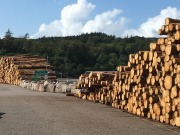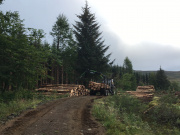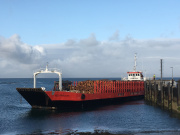TImber eiggxport
Community landowners Isle of Eigg Heritage Trust manage 247ha of forest land – a mixture of commercial plantation and native woodland, including 70ha of harvestable Sitka Spruce. Working with and approved by Scottish Forestry, the community landowners have designed a Forest Plan which includes a phased programme of harvesting over 20 years to make sustainable use of the forest.
Their eventual aim is to ensure that the island will not have to experience large-scale tree felling again. Community engagement and participation in designing and delivering the Forest Plan has been crucial in shaping how the Trust approached this challenging timber transport project.
Approach
This is the largest-scale environmental improvement project on Eigg in over 10 years with considerable practical challenges, not least of which is that the island has one 5km single track road with few passing places. Aware of the islanders’ concerns, the Trust knew this had to be managed sensitively. They took the decision very early on to manage and deliver the project themselves, with the aim to find a bespoke solution to minimise impact on the island and its residents.
The active participation of the community of Eigg and other stakeholders in the design and delivery of the plan was essential for the Trust. Communication and engagement with the community was prioritised from the beginning of the process: an information pack was compiled and shared with all residents; there were regular open meetings and workshops; and site visits with Q&As, pre and during harvest, were held. An open line of communication is part of the normal business of the Trust. Monthly updates are sent out to residents and through this and social media, regular updates on the timber harvest were shared. Hard copies were handed out to those who had no access to email to ensure everyone was kept up-to-date. Information was also displayed at the Pier Centre to keep visitors informed.
The Trust worked with Highland Council, Community Woodlands Association and local contractors, to manage operations with care and consideration. They also benefited from peer support from Community Land Scotland and Knoydart Forest Trust. Mitigations included timing work to protect nesting birds, using small scale haulage equipment to protect fragile roads and low ground pressure machines to protect water and soil, and working around the ferry timetable and planned activities to avoid disruption and ensure public safety.
Benefits and Lessons Learned
The collaborative approach taken has led to a timber transport project which has a real sense of investment and support from the community. The capacity and confidence of the Trust’s staff and trustees have increased significantly, and they have identified key learning points:
- Investing in a programme of communication, engagement and feedback delivers real benefits
- Be visible, available and aware of the benefits of informal engagement- being open and transparent builds relationships and trust
- Tell the wider story – this improved public understanding of the role of forestry in combating climate change and the importance of sustainable forest management
- Use the expertise, support and funding opportunities available - the Trust found the input from all stakeholders and particularly the local contractors, Glencoe Timber Ltd, Wood Knoydart and Troon Tug Co, to be ‘worth its weight in gold.’
Find Out More
Rebecca Long Good Practice Team
Development Manager Scottish Land Commission
Isle of Eigg Heritage Trust Tel: 01463 423 300
Tel: 01687 482 476 Email: goodpractice@landcommission.gov.scot
Email: ieht@isleofeigg.net


